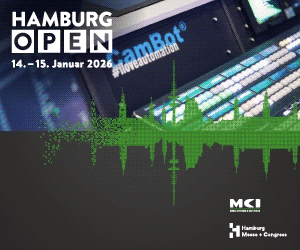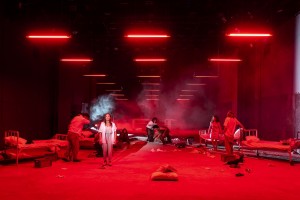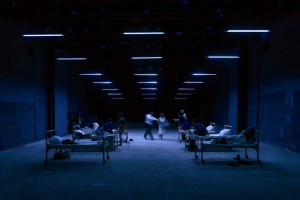Aktuelle News & Schlagzeilen
Astera Titan Tubes illuminate at 2025 Athens Epidaurus Festival
At this year’s Athens Epidaurus Festival, lighting designer Christina Thanasoula - of Athens, Greece-based creative design studio Creative Lighting - utilised Astera’s Titan Tube fixtures for two intense and very different dramas - the world premiere of “Blindness”, directed by Emily Louizou; and “Phenomenon”, directed by Katerina Giannopoulou.
“Blindness” is based on the novel by José Saramago, adapted for stage by Simon Stephens, and tells the story of an epidemic of blindness which interrogates the spirit and meaning of humanity in destructive circumstances. It was staged in Venue E of one of the festival’s main sites at 260 Peiraios Street, a bare-stage former factory in central Athens.
The main setting for the play was an abandoned psych hospital ward, complete with raw, crude, and uncomfortable fluorescent lighting - characteristic of so many institutions. Thanasoula needed a versatile lightsource offering an array of whites plus some very specific colours to replicate this unnerving environment.
Having worked with Astera products for some time, she included 24 Titan Tubes in the technical specification and equipment list needed for staging the play four months in advance and well ahead of even the first rehearsals. This ensured that the Titan Tubes would be viewed as a main feature of the performance’s visual identity.
“The stage needed to look dirty, musty, dilapidated”, she explains. “Lighting played a key role in defining the location and assisting the action.” As the Titan Tube has a contemporary look, Thanasoula and set designer Thalia Melissa worked closely to disguise them in some battered scenic housings that helped create the stark ambience of the psych ward, where they now resembled institutionalised hospital fluorescents, effectively becoming fundamental to the scenography.
The set department created scuffed and worn-out covers for the Titans, which were hung in the roof of the performance space and powered through wired connections. They were the main lighting element of the production, supported by other LED sources and some tungsten lighting.
Around 140 lighting cues were programmed into a ChamSys MagicQ console. Flickering and oscillating effects were programmed to give an additional layer of illuminative texturing together with a series of dirty, unpleasant red, green and amber flourishes.
The Titan Tubes were rigged in rows that accentuated the 30-metre depth of the space, also allowing movement effects between the linear rows of lights following the fast and pacey action of the piece, while syncing to the tempo of Irene Skylakaki’s specially created soundscape.
“It was a fine balance of creating emotion whilst not making it too overwhelming for the audience, ensuring that lighting enhanced and supported the actors, making everything more realistic and yet stimulating everyone’s imaginations”, says Thanasoula.
Two weeks later, also for the Epidaurus Festival, she was lighting “Phenomenon” - a tense contemporary study of knowledge and doubt written by Greg Liakopoulos and inspired by Wittgenstein’s “On Certainty” - staged in Venue D at 260 Peiraios Street. The performance postulates on dialectical issues related to distinguishing between real and artificial in an era where rendering and simulation technologies are widely accessible.
Many scenes are set in a car with live camera feeds to screen and projections. Thanasoula worked closely with set designer Niki Psyhogiou, who also created the costumes, and camera operator Yorgos Kyvernitis. She chose Titan Tubes again, this time running them wirelessly and applied in a more classically cinematic context as in-car fill and for key lighting of the protagonists. The luminaires were also utilised for highlighting dramatic moments and effects, e.g. when a body showed up in the trunk of the car.
The eight Titan Tubes had to be carefully positioned and colour-balanced to match the live camera feeds of the filmed actors in the car to pre-recorded background video content of the highway, complete with passing cars and street lights, which was “particularly challenging”, according to Thanasoula.
Fine-tuning of colour and intensity ensured that all lighting fixtures (both tungsten and LED sources) appeared consistent and accurate on camera, while also delivering a cohesive live experience for the audience watching the actors on stage. Their performance still had to be interesting and emotion-evoking.
Balancing the picture for both digital and human eyes is galvanising, and “the Astera fixtures were a great help here”, states Thanasoula. Titan Tubes were also used directly as handheld practicals by the actors who moved them across the top of the car, creating an illusion of passing lights above the roof.
Flicker-free operation and high CRI were vital, as Thanasoula used the Titan Tubes similar to a gaffer in composing lighting for TV recordings and filmed shots. The “Phenomenon” lighting, including all Astera effects, was programmed and run on a GrandMA3 console with around eighty cues in total.
(Photos: Elina Giounanli/Nophoto.gr)
SCHLAGZEILEN
news archiv
suche
© 1999 - 2025 Entertainment Technology Press Limited News Stories











